Journal – November 2022
 | | Image by Petra |
|
In This Issue
|
|
Mark Blackham  Welcome to the November 2022 edition of the Urantia Association's Journal, a publication dedicated to the thoughts, observations, and experiences of Urantia Book students from around the world. Our contributors explore a wide range of topics, including personal stories of spiritual discovery, finding new meanings and values, and enhancing spiritual perception. Others write about cosmology, science, and ways to improve global civilization. Throughout all these articles, we see an extraordinary diversity of thought coupled with a spirited unity of purpose.
Welcome to the November 2022 edition of the Urantia Association's Journal, a publication dedicated to the thoughts, observations, and experiences of Urantia Book students from around the world. Our contributors explore a wide range of topics, including personal stories of spiritual discovery, finding new meanings and values, and enhancing spiritual perception. Others write about cosmology, science, and ways to improve global civilization. Throughout all these articles, we see an extraordinary diversity of thought coupled with a spirited unity of purpose.
Our first article, Our Missing Mother God: Monotheism at the Cost of Trinitarianism by Elisabeth Callahan, is an insightful and novel essay centered on the Mother concept of God. Elisabeth has conducted several classes and forums at the Urantia University Institute on the nature of the local universe Mother Spirit as well the maternal characteristics of the Eternal Son and God the Supreme. In this essay, she makes the case that the continued focus on a male dominated monotheism in world religions detracts from the higher truth inherent in the nature of trinitarianism and, in the process, has devalued the maternal creative function.
She points out that The Urantia Book, although it carries on the tradition of male-centric language, also provides significant detail about the nature and characteristics of the Creative Daughter and her personalized presence as the Holy Spirit, as well as the workings of her many agencies throughout the grand universe.
Elisabeth feels that an emphasis on the Father-Son concept of God tends to overlook the unique characteristics of our Divine Mother and thereby ignores the higher reality of a “Three-Persons-in-One-God,” a concept that embodies a Divine Family of Father, Mother, and Child, all of whom are equal and one with each other. This, she suggests, not only has a social impact on the relative value of men and women in society but also affects the tenor of our culture and institutions as well as our awareness of our environment, even our spiritual environment.
“I think it is fair to suggest that such an imbalance in our understanding of God adversely affects cultural development and the progress of civilization towards light and life insofar as the proper integrated functioning of Love and Law in society is not achieved.”
The second article, My Relationship to God – My Mother and Father by Kurt Cira, is an account of his personal spiritual experiences and how much his concepts about the divine nature of God have changed since he picked up The Urantia Book fifty years ago. In particular, he speaks of his growing realization of God as Mother as well as Father and how these two divine natures “are perfectly designed to complement and complete the other.” Kurt stresses the importance of learning about the model of cooperation and coordination between the Creator Son and the Creative Daughter in order to improve the ways in which the masculine and feminine can work together.
He uses the analogy of a ROPE (religion of personal experience) to explain his two different approaches to God, one is his relationship with God the Father and the other is his relationship with the Divine Mother. Each relationship has a unique flavor, a unique function, and a unique influence on his spiritual life. And by working in harmony with both, he suggests we can reach “a full and balanced blending of all the best characteristics of each gender.”
Kurt’s candid descriptions of his personal religious experiences should encourage all of us to do as he does, namely “to develop a deeper relationship with God by developing daily spiritual practices.”
Our third article, The Psychic Circles and the Morontial Life by André Desjardins, is a fascinating foray into the meanings of the seven psychic circles of human progression. André suggests that, by reaching these successive circles of attainment, we bring ourselves closer and closer to a true morontia existence in our earthly lives.
A very original feature of André’s essay is that he not only digs out the qualities and characteristics that define the seventh, third, and first circles as defined by The Urantia Book but he also theorizes on the nature of the remaining circles.
In a progression of thought, André also proposes four segments, or groupings, of psychic circles, each defined by a particular stage of evolutionary growth and morontia progression. For all of you who wonder what is required to advance in the circles, this is a must-read.
The fourth article, The Word, the Language, the Dictionary by Peter Walker, was previously published on the southeasturantia.com website and we thank Peter for allowing us to republish it here.
Peter’s essay is an outgrowth of his search for the origins of the Urantia Papers. In particular, it is an etymological quest for the meaning of “Urantia.” In his search, he leaves no stone unturned, leading to the discovery of a beautiful, spiritual interpretation.
Peter also takes us on a short journey through the transformation of languages and suggests that, after 85 years, some of the original meanings of words in The Urantia Book have changed, and will continue to change in the years to come. To remedy the potential for future misreading of the text, he cites the necessity of having dictionaries from the early 20th century readily available to Urantia Book students.
|
|
Elisabeth Callahan, USA 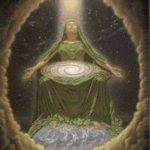 Back in the late 1980s, while engaged in a graduate program in transpersonal psychology, I took a class in Creation Spirituality with Matthew Fox, the former Dominican priest, theologian, and author of 37 books including Creation Spirituality: Liberating Gifts for the Peoples of the Earth. This was my first significant foray into the idea that God has a pervasive, life-giving, maternal creative function.
Back in the late 1980s, while engaged in a graduate program in transpersonal psychology, I took a class in Creation Spirituality with Matthew Fox, the former Dominican priest, theologian, and author of 37 books including Creation Spirituality: Liberating Gifts for the Peoples of the Earth. This was my first significant foray into the idea that God has a pervasive, life-giving, maternal creative function.
At the time, from the viewpoint of the magisterium of the Roman Catholic Church, Fox’s perspective bordered on heresy. He was booted from the Dominican priesthood but later, in 1994, he was received as a priest in the Episcopal Church by Bishop William Swing.
Nonetheless, the concept of creation spirituality was planted in my mind as something worth pondering. Creation spirituality posits that God is in all things (panentheism), that divinity permeates all things, and that all things bear the energetic blueprint of divinity. That is not to say that God is all things, which is a pantheistic assertion, although it is true to say that without God or a Primal Cause, nothing would exist.
There is a resonance of this attribute of God’s everywhereness in the Urantia revelation where we read that “The Infinite Spirit pervades all space and indwells the circle of eternity” [34:3.2]. The same is true of the Creative Daughters of the Infinite Mother Spirit at the local universe level. Consider the statement that “the Divine Minister of Salvington is everywhere in Nebadon” [45:1.8].
When the Creative Daughter commences the awesome act of conjoint creation with the Creator Son, we learn that, from the vast energy source of her being, “there proceed the established currents and the ordained circuits of spirit power and spiritual influence destined to pervade all the worlds and beings of that local universe” [34:1.2]. From this passage, and other references throughout the Urantia revelation, we can glean a picture of an all-enveloping spiritual omnipresence that permeates all the space, all the architectural and evolutionary worlds, and all the beings of the Mother Spirit’s universe with diverse currents of spiritual-mindal energy and discrete channels of her personal presence that provide her with the means to connect and communicate with all the inhabitants of her universe.
These manifest powers and attributes help us to better understand the nature of this great Creative Daughter of the Infinite Spirit and her omnipresent function as the Divine Mother of all her creatures, the source of life, mind, and spirit power in the universe. She is wholly different in her omnipresent nature and in many other functions from the Creator Son, the Father of our local universe and the unique, original Son of the Universal Father and Eternal Mother Son.
The Creator Son is a divine being who, unlike the Creative Daughter—his eternal co-creative and co-ruling partner—is wholly unlimited by the constraints of time in the grand universe, but who can only be in one discrete location at a time, unlike the Divine Mother who is everywhere within the bounds of her local universe.
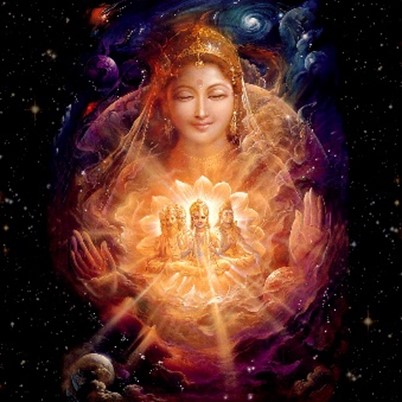 How overlooked and under-appreciated is the Divine Mother in most world religions, except for Hinduism which reveres the Great Mother Goddess Devi, the one who embodies all aspects of womanhood and motherhood. Devi is as powerful as the top male gods of the Hindu Trinity—Vishnu and Shiva. While gentle, loving, and nurturing in her motherly function, Devi is also sometimes fierce in the exercise of her awesome cosmic power to create and destroy worlds.
How overlooked and under-appreciated is the Divine Mother in most world religions, except for Hinduism which reveres the Great Mother Goddess Devi, the one who embodies all aspects of womanhood and motherhood. Devi is as powerful as the top male gods of the Hindu Trinity—Vishnu and Shiva. While gentle, loving, and nurturing in her motherly function, Devi is also sometimes fierce in the exercise of her awesome cosmic power to create and destroy worlds.
Our Divine Mother – MIA (Missing in Action)
While I had already been exposed to the Universe Mother Spirit in The Urantia Book, I tended to pass over her everywhere presence in space and mind and her awesome creative powers, as perhaps many other Urantia Book readers have done. In fact, it seems to me the Father concept of God overshadows the Mother concept of God in The Urantia Book to such an extent as to almost obliterate the maternal aspect of God, somewhat akin to the hazy glow of the moon lost in the bright light of the sun.
Growing up in the western patriarchal culture of Judeo-Christianity, the anthropomorphic image of God presented to me was completely male in terms of an Old Testament Father God and the New Testament Son of God. Why did I not sooner question the missing mother in the divine family of the Paradise Trinity? Is religious culture so pervasive that, like a fish in water that does not question the water which surrounds it, we do not even notice or question the absence of the mother function in the symbolic representation of the Trinity?
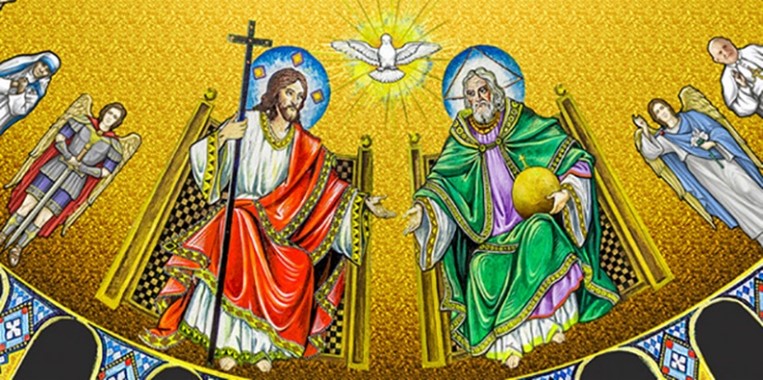
The meme above has circulated around the Internet. What’s wrong with this picture?
The first thing that comes to my mind is that the Infinite Spirit is a Person. We need a better, more truth-revealing symbol of the Infinite Spirit and Creative Mother Spirit for the new millennium and beyond because there is a growing rejection of the old Christian symbology. A bird symbol is simply not adequate, chiefly because it lacks personality—personal spiritual omnipresence.
The Infinite Spirit is just as much a complement of the Eternal Son as the Son is a complement of the Universal Father. The Eternal Son is a spiritualized personalization of the Father; the Infinite Spirit is a personalized spiritualization of the Eternal Son and the Universal Father. [Paper 9:2.2, page 100.4 emphasis added]
Those who study divinity in the Urantia revelation know that the Universal Father is not alone in infinity and has never acted alone in the cycles of eternity, notwithstanding the absolute truth that he is the First Source and Center of all that is. Always existentially and eternally co-present are the other two Absolutes—the Eternal Mother Son and the Infinite Spirit, the Conjoint Actor of the Trinity. This is the Original Family Relationship of Paradise. All Three Persons, in the undivided unity of the Paradise Trinity, appear to be necessary for the creation, diversity, variability, and maintenance of the grand universe in the present Age of the Supreme.
While reason demands a monotheistic unity of cosmic reality, finite experience requires the postulate of plural Absolutes and of their co-ordination in cosmic relationships. Without co-ordinate existences there is no possibility for the appearance of diversity of absolute relationships, no chance for the operation of differentials, variables, modifiers, attenuators, qualifiers, or diminishers. [Paper 104:3.4, page 1146.6]
So where is the mother aspect of God in the religious cultures of our evolutionary world, particularly in the Judeo-Christian and Islamic traditions?
What happened to arrest the development of the true Trinity concept in the Western world—the reality of a Three-Persons-in-One-God who demonstrates a Divine Family of Father, Mother, and Child who are equal and one with each other?
There are numerous descriptions of the Three Persons of the Paradise Trinity and their family relationship in the Urantia revelation:
Concerning identity, nature, and other attributes of personality, the Eternal Son is the full equal, the perfect complement, and the eternal counterpart of the Universal Father. In the same sense that God is the Universal Father, the Son is the Universal Mother. And all of us, high and low, constitute their universal family. [Paper 6:8.1, page 79.4]
The first act of the Infinite Spirit is the inspection and recognition of his divine parents, the Father-Father and the Mother-Son. He, the Spirit, unqualifiedly identifies both of them. He is fully cognizant of their separate personalities and infinite attributes as well as of their combined nature and united function. [Paper 8:1.2, page 90.6]
The Infinite Spirit is a complete and perfect personality, the divine equal and co-ordinate of the Universal Father and the Eternal Son. [Paper 8:6.2, page 96.4]
The Son and the Spirit now preside over the universe much as a father and mother watch over, and minister to, their family of sons and daughters. [Paper 33:3.7, page 369.2]
Returning to the idea of our missing Divine Mother, what might be the fallout on a sociological level of our impoverished spiritual thinking about the Father God and Mother God, functions of the existential Trinity, their pattern of divine family, as well as our Local Universe Divine Parents, on the development of religious culture and civilization in our evolutionary world? And what might be the subsequent impact of this deficient and unbalanced view of Deity on the roles and relative value of men and women in society and their unequal status in many world cultures?
These are questions, I think, that we ought to be raising as students of the Urantia revelation, which has as one of its primary purposes the upgrading of evolutionary religions, spiritual thinking, and planetary civilization. While we cannot address these questions adequately within the scope of this article, I do think it is up to us as religious thinkers—men and women alike—to address this vital intersection of revelation and evolution and contribute higher divine concepts to the further spiritual awakening of humankind.
The study of human religion is the examination of the fossil-bearing social strata of past ages. The mores of the anthropomorphic gods are a truthful reflection of the morals of the men who first conceived such deities. Ancient religions and mythology faithfully portray the beliefs and traditions of peoples long since lost in obscurity. These olden cult practices persist alongside newer economic customs and social evolutions and, of course, appear grossly inconsistent. The remnants of the cult present a true picture of the racial religions of the past. Always remember, the cults are formed, not to discover truth, but rather to promulgate their creeds. [Paper 92:3.1, page 1005.3]
Modern man is adequately self-conscious of religion, but his worshipful customs are confused and discredited by his accelerated social metamorphosis and unprecedented scientific developments. Thinking men and women want religion redefined, and this demand will compel religion to re-evaluate itself. [Paper 92:7.13, page 1013.8 emphasis added]
Modern man is confronted with the task of making more readjustments of human values in one generation than have been made in two thousand years. And this all influences the social attitude toward religion, for religion is a way of living as well as a technique of thinking. [Paper 92:7.14, page 1013.9]
This article is an attempt to raise questions about the relationship of confused and outmoded theological concepts and symbols to the development of religious culture and civilization. And it’s an effort to introduce higher spiritual concepts and promote the cross-fertilization of ideas and values in discussions between thinkers in the fields of revelatory religion, philosophy, social psychology, and social-cultural anthropology, including the anthropology of religion.
Religious concepts and values are inseparable from social culture. They have shaped the development of society and culture from the very first humans. The way we think about God, the meaning of existence, what lies beyond death, and the value we assign to persons and all life, profoundly and absolutely influences the evolution of our folkways, mores, taboos, and laws—the social norms that govern our beliefs, behavior, and interactions with others.
The progress of world civilization toward light and life depends greatly on the higher spiritual meanings and values of revealed religion, the Urantia revelation being the latest such divine framework for helping our world cultures to evolve spiritually, socially, and intellectually.
Yes, We Do Have a Creative Mother God, but She is Submerged in Many World Cultures
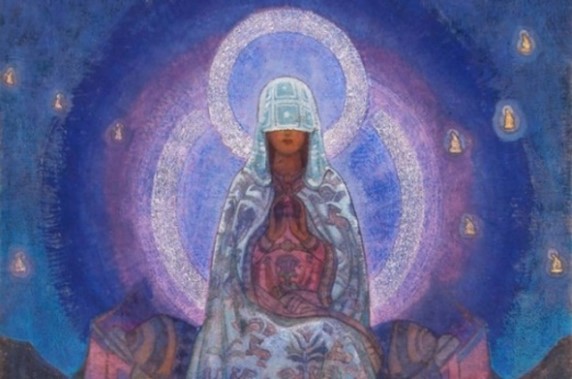 Going back to my class on creation spirituality, Matthew Fox stated an idea that seared itself in my mind and has stirred my thinking ever since. He spoke words to the effect that, “If I wanted to create a world that would be doomed to eventual extinction, I would create a world with only a Father God and no Mother God.”
Going back to my class on creation spirituality, Matthew Fox stated an idea that seared itself in my mind and has stirred my thinking ever since. He spoke words to the effect that, “If I wanted to create a world that would be doomed to eventual extinction, I would create a world with only a Father God and no Mother God.”
Although the concept of the Blessed Trinity was emblazoned in my soul as a child, I was ignorant of the mother-like character of God. Suddenly I saw the Roman Catholic religion in which I had been raised in a whole new light. It was missing God the Mother and that void was so glaring—and revealed a need for a Mother God so great—that billions of Catholics over the centuries had practically deified Mary, the human mother of Jesus, to fill the missing space.
But Mary was, after all, only human, not a Person of the Paradise Trinity. Yet for the last two thousand years, countless millions have shown her the reverence, love, and near-worship that is usually reserved for God the Father in Paradise. Why?
One answer to the question may be the existence of a deep and ancient need in the human psyche—embedded there by both earlier epochal revelations of the Paradise Trinity to humankind and by the adjutant mind spirit of worship and the Holy Spirit that have been at work for a million years in our progressive human evolution—for a feminine representation of God as Mother to balance and complement an all-powerful Father God.
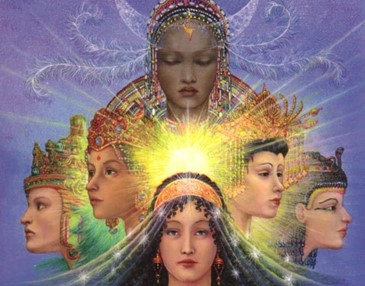 This is evidenced by the many female personifications of Deity that are found in the animistic religions and artifacts of ancient societies as well as the major religions of Asia. Some of the better-known goddesses are Gaia, Isis, Hecate, Rhea, Thiên Y A Na, Devi, Parvati, Durga, Kali, Saraswati, Lakshmi, Tara, and Kwan Yin.
This is evidenced by the many female personifications of Deity that are found in the animistic religions and artifacts of ancient societies as well as the major religions of Asia. Some of the better-known goddesses are Gaia, Isis, Hecate, Rhea, Thiên Y A Na, Devi, Parvati, Durga, Kali, Saraswati, Lakshmi, Tara, and Kwan Yin.
In fact, we do have an unrecognized Mother God who is utterly personal and mindally present in our bodies through her Adjutant Mind Spirits and her Holy Spirit. She is in us and all around us in her pervasive everywhere presence. Our beingness is suffused with the mind and life energy of the Mother. And she ministers to us through her countless daughter spirits, our seraphic guardians.
In fact, like the fish that are unaware of water because they are so completely in it as to not even recognize it or question it, so too, do we exist unaware of the pervasive mind and energy fields of the Creative Mother Spirit. But with the proper education, techniques, and encouragement to enhance our spiritual perception, we might just be able to develop the ability to become conscious of, and tune into, the triune spiritual influences in us and around us, including the personalized spiritual presence of the Holy Spirit.
Again, The Urantia Book provides us with significant detail about the all-pervading spiritual presence of the Infinite Spirit, the Creative Daughters of the Infinite Spirit, and our contact with her personalized presence. Are we not told the fundamental quality of personality is its ability to always recognize and make contact with other personalities?
In personal prerogatives a Creative Spirit is … equally and diffusely present throughout her entire local universe and is, therefore, just as literally and personally present on one world as on any other. [Paper 34:3.3, page 376.6 emphasis added]
This personalized presence of the Infinite Spirit, the Creative Mother Spirit of the local universe, is known in Satania as the Divine Minister. To all practical intents and spiritual purposes, this manifestation of Deity is a divine individual, a spirit person. [Paper 34:1.4, page 375.3 emphasis added]
There are numerous passages in The Urantia Book that inform us of the ways that we are connected to God, including the Mother Spirit’s direct line to personal beings through her Holy Spirit, as in the following passage:
The presence of the universal spirit of the Eternal Son we know — we can unmistakably recognize it. The presence of the Infinite Spirit, the Third Person of Deity, even mortal man may know, for material creatures can actually experience the beneficence of this divine influence which functions as the Holy Spirit of local universe bestowal upon the races of mankind. [Paper 9:2.5, page 100.7 emphasis added]
Epochal Revelations of the Trinity Concept
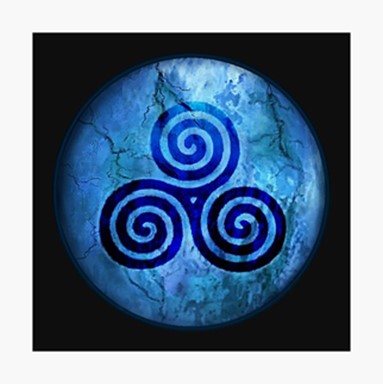 In searching The Urantia Book over the years for clues about our missing Divine Mother, I found at least part of the answer for her disappearance (or submergence as the case may be) in Paper 104, “Growth of the Trinity Concept.” Even long-time students of The Urantia Book may have overlooked the fact that the revelation of the Paradise Trinity—the Universal Father, the Eternal Mother Son, and the Infinite Spirit—was made by the Prince’s staff to the people of Urantia half a million years ago. It sadly vanished in the darkness that overcame our world after the planetary rebellion some 200,000 years ago [104:1.1].
In searching The Urantia Book over the years for clues about our missing Divine Mother, I found at least part of the answer for her disappearance (or submergence as the case may be) in Paper 104, “Growth of the Trinity Concept.” Even long-time students of The Urantia Book may have overlooked the fact that the revelation of the Paradise Trinity—the Universal Father, the Eternal Mother Son, and the Infinite Spirit—was made by the Prince’s staff to the people of Urantia half a million years ago. It sadly vanished in the darkness that overcame our world after the planetary rebellion some 200,000 years ago [104:1.1].
The Trinity concept was later revived and taught by Adam and Eve around 38,000 years ago in the first and second gardens [104:1.2]. However, with the default of the Adamic mission and the passage of many millennia, the concept of a Three-in-One God had faded by the time Machiventa Melchizedek appeared on the world stage around 4,000 years ago, although it was not altogether obliterated thanks to the teachings of the Sethite priesthood [104:1.5].
Machiventa Melchizedek’s primary mission was to prevent the extinction of revealed truth about God, including the Trinity concept, and to revive the concept of One God Above All Gods, thereby preparing the minds of humanity for greater receptivity to the imminent human bestowal mission of the Creator Son on our world. Machiventa accomplished this supreme objective by developing a school of missionaries who went to the ends of the earth with their message of El Elyon, the Most High, and the Trinity concept tucked in there for those who could receive it.
It’s fascinating to note that the Salem missionaries found a much greater receptivity for the Trinity concept in the cultural minds of the people of India and China than they did in the West.
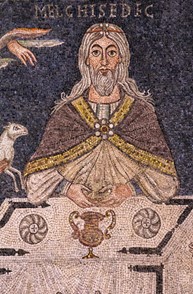 Through the activities of the Salem missionaries the Melchizedek teachings of the Trinity gradually spread throughout much of Eurasia and northern Africa.
Through the activities of the Salem missionaries the Melchizedek teachings of the Trinity gradually spread throughout much of Eurasia and northern Africa.
Among the Hindus the trinitarian concept took root as Being, Intelligence, and Joy. (A later Indian conception was Brahma, Siva, and Vishnu.) While the earlier Trinity portrayals were brought to India by the Sethite priests, the later ideas of the Trinity were imported by the Salem missionaries and were developed by the native intellects of India through a compounding of these doctrines with the evolutionary triad conceptions.
The Buddhist faith developed two doctrines of a trinitarian nature: The earlier was Teacher, Law, and Brotherhood; that was the presentation made by Gautama Siddhartha. The later idea, developing among the northern branch of the followers of Buddha, embraced Supreme Lord, Holy Spirit, and Incarnate Savior. [Paper 104:1.4-6, pages 1144.1-3]
While the trinitarian concept took root in Hinduism and Buddhism, it failed to take hold among the Hebrews and the people of the Near East who clung tenaciously and zealously to a monotheistic Father God at the expense of the Trinity concept of God. The author of Paper 104 also asserts that the followers of Mohammed later had the same intellectual difficulty as the Hebrews in tolerating a trinitarian God, for they could not reconcile it with monotheism, the doctrine of one God. They, too, found it difficult to separate the concept of trinitarianism from that of polytheism [104:1.9].
Machiventa found it very difficult to teach the Palestinian Bedouins about the Universal Father, the Eternal Son, and the Infinite Spirit. Most of his disciples thought that the Trinity consisted of the three Most Highs of Norlatiadek… [Paper 104:1.3, page 1143.6]
The Hebrews knew about the Trinity from the Kenite traditions of the days of Melchizedek, but their monotheistic zeal for the one God, Yahweh, so eclipsed all such teachings that by the time of Jesus’ appearance, the Elohim doctrine had been practically eradicated from Jewish theology.
The followers of the Islamic faith likewise failed to grasp the idea of the Trinity. It is always difficult for an emerging monotheism to tolerate trinitarianism when confronted by polytheism. The great monotheists, the Hebrews and Mohammedans, found it difficult to distinguish between worshiping three gods, polytheism, and trinitarianism, the worship of one Deity existing in a triune manifestation of divinity and personality. [Paper 104:1.8-9, pages 1144.5-6 emphasis added]
Jesus did not fare much better with his disciples in attempting to elevate and expand their thinking about God beyond the racial concept of Yahweh, the advanced idea of the Lord God of Israel.
Jesus taught his apostles the truth regarding the persons of the Paradise Trinity, but they thought he spoke figuratively and symbolically. Having been nurtured in Hebraic monotheism, they found it difficult to entertain any belief that seemed to conflict with their dominating concept of Yahweh. And the early Christians inherited the Hebraic prejudice against the Trinity concept. [Paper 104:1.10, page 1144.7]
Jesus reminded his disciples of the plural meaning of Elohim, the earlier name for God among the Hebrews, which was later supplanted by the singular monotheistic concept of Yahweh:
Elohim. From the times of Adam the teaching of the Paradise Trinity has persisted. Do you not recall how the Scriptures begin by asserting that “In the beginning the Gods created the heavens and the earth”? This indicates that, when that record was made, the Trinity concept of three Gods in one had found lodgment in the religion of our forebears. [Paper 142:3.6, page 1598.7]
Thus, for many reasons having to do with cultural linguistics and the religious mindset of the Hebrews and other ancient Semitic tribes, the Trinity concept did not gain traction in the Near East. Instead, it gave way to an enduring, paternalistic, monotheistic God that squeezed out the mother function of God and the concept of the Paradise Trinity as a Divine Family of Personal Deities.
The Long Slow Path to Recognizing, Understanding, and Embracing the Trinity Concept
I would like to advance the idea that a primary concept of God that the religious minds of our generation and the future must crack open and absorb into our evolving belief systems and progressive planetary civilization is: Trinitarianism and monotheism are not contradictory or incompatible.
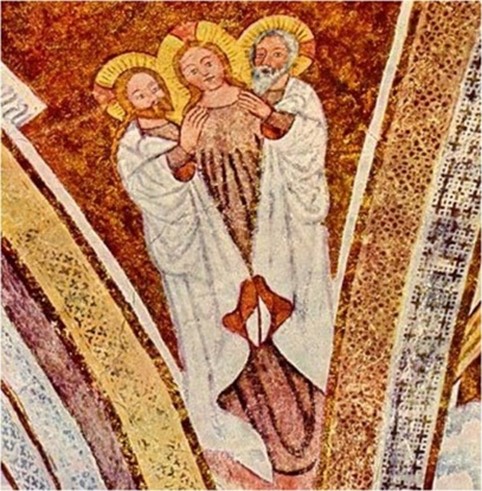 The One God of All embraced in monotheism is actually and has always been Three-Persons-in-One-God! The Trinity of Three Existential Persons of Eternity—the Three Sources and Centers of absolutely everything that exists in the Universe of universes—was revealed many times in the past but was poorly understood, often rejected, and lost time and time again in the course of human evolution.
The One God of All embraced in monotheism is actually and has always been Three-Persons-in-One-God! The Trinity of Three Existential Persons of Eternity—the Three Sources and Centers of absolutely everything that exists in the Universe of universes—was revealed many times in the past but was poorly understood, often rejected, and lost time and time again in the course of human evolution.
The embrace of Trinitarianism enables people to realize and make use of the knowledge that each of the Three Paradise Deities has unique and diverse functions that nurture us, teach us, guide us, and help us grow in Godlikeness as they draw us toward them in Paradise through the personality circuit of the Father, the spirit gravity of the Son, the mind gravity of the Spirit, and the stupendous activity of God the Sevenfold in the evolutionary universes of space and time.
In combination and association, the Paradise Trinity presents evolutionary minds with a balanced approach to the qualities and attributes of God which are chiefly LOVE and LAW. In a way, these aspects of the nature of God represent a balanced blend of mother-like and father-like qualities in the very fabric of life itself in the grand universe.
However, if any one or two of the Persons of the Trinity are diminished or removed from the religious cultural understanding of God, then I think people suffer the relational loss, in some measure, of those associated characteristics and traits of God in their collective culture and personal belief system.
I think it is fair to suggest that such an imbalance in our understanding of God adversely affects cultural development and the progress of civilization towards light and life insofar as the proper integrated functioning of Love and Law in society is not achieved. We may suffer from an over-emphasis on Law at the expense of Love and become slaves to authority. Conversely, an over-emphasis on Love at the expense of Law may lead to a lack of discipline and self-regulation.
This imbalance shows up in many social groupings and religious cultures, as we are presently witnessing in Iran’s severe civil unrest and America’s culture wars. In contrast with the imperfect evolutionary worlds of the superuniverse, the proper balance of Love and Law is perfectly manifest in the exquisite harmony of Paradise-Havona.
Through the recognition of the Trinity concept, the mind of man can hope to grasp something of the interrelationship of love and law in the time-space creations. Through spiritual faith, man gains insight into the love of God but soon discovers that this spiritual faith has no influence on the ordained laws of the material universe. [Paper 104:2.3, page 1145.4]
Interestingly, the early Christians had a concept of the Trinity, albeit a confused one concerning the nature and function of each of the Three Persons of Deity. In the study of the doctrinal history of the Trinity in the Christian religion, one observes there has long been debate and confusion about the Godhead, especially the Third Person of the Trinity.
In fact, Eastern and Western Christianity remain divided to this day, among other theological issues, on whether or not the Third Person of the Trinity—the Holy Spirit—proceeds from the Father and the Son, or only from the Father. This dispute ultimately led to the Great Schism between Catholicism and the Orthodox Church in 1054, with Catholics upholding the view of the origin of the Spirit in both the Father and the Son.
Various Christian sects disagree about the Godhead, and whether or not the Holy Spirit is even a person or just an energy or life force of God. Jehovah’s Witnesses, for example, do not believe in the Trinity. They believe that God is almighty, Jesus is a mighty God, and the Holy Spirit is God's active force.
Other Christian sects interpret the Holy Spirit as what the Urantia revelation calls the Spirit of Truth. None understand the Holy Spirit as the Creative Daughter of the Infinite Spirit, the personal presence of the Universe Mother Spirit who is the bestower of life and mind in her evolutionary universe. None currently know her as the eternal co-creator and co-ruler with our Creator Son Michael of the local universe in which we live.
Consider what The Urantia Book tells us about the early Christian concepts of the Trinity:
The first Trinity of Christianity was proclaimed at Antioch and consisted of God, his Word, and his Wisdom. Paul knew of the Paradise Trinity of Father, Son, and Spirit, but he seldom preached about it and made mention thereof in only a few of his letters to the newly forming churches. Even then, as did his fellow apostles, Paul confused Jesus, the Creator Son of the local universe, with the Second Person of Deity, the Eternal Son of Paradise.
The Christian concept of the Trinity, which began to gain recognition near the close of the first century after Christ, was comprised of the Universal Father, the Creator Son of Nebadon, and the Divine Minister of Salvington—Mother Spirit of the local universe and creative consort of the Creator Son.
Not since the times of Jesus has the factual identity of the Paradise Trinity been known on Urantia (except by a few individuals to whom it was especially revealed) until its presentation in these revelatory disclosures. [Paper 104:1.11-13, pages 1144.8-1145.1]
From these passages, we can see that our world has a long way to go intellectually and spiritually in coming to recognize, accept, and embrace the mystery of Three-Persons-in-One-God. Perhaps we can also discern that the deeply embedded concept of a single, monotheistic, paternalistic God, divorced from a proper understanding of the other two Deities of the Paradise Trinity, is an impediment to the progress of our spiritual planetary civilization.
Tens of millions of people in the modern age are rejecting Christianity (not Jesus per se) for good reason because of its outmoded symbols and refusal to keep pace with the evolution of culture. A steadily growing segment of the western world, in particular, refutes the concept of an Old Testament God that is still embedded in our culture as a stern, judging, authoritarian, punishing Father figure. This is the very symbolic image that Jesus did his best to supplant with his teaching of a loving, all-forgiving Father in heaven and the divine family of God.
The price we pay for the outmoded and severely limiting concept of monotheism, I think, is the loss of the plenitude of meanings and values that are available in the Trinity. Monotheism must yield sooner or later to the realization and fuller appreciation of the beneficent gifts, powers, and influences of all Three Persons of the Trinity—the Universal Father, Eternal Mother Son, and Conjoint Actor (Infinite Spirit) in equal measure—and their Creator Sons and Creative Daughters who go out into the superuniverses of space and time to form their own divine families.
There is an undeniable relationship between our individual and collective realization and embrace of the Original Family of Paradise, along with the Divine Parents of our local universe, and the cultural and spiritual meanings and values we place on men, women, children, and families in our global civilization.
We can see signs of a stirring, a new awakening, in the collective spiritual consciousness of humankind in the 20th and 21st centuries to expand the concept of God from a single Father alone in the void, to a Trinity of Deities who are utterly loving, personality-bestowing, life-giving, lawgiving, mind-endowing, and continuously ministering to us, in an unceasing effort to help us grow up to become like them.
Their boundless, individual and undivided, personal natures are the essence and source of LOVE and all that is good, true, and beautiful. They have created everything in love and by law. Ever must these two realities of love and law, of mother-like and father-like characters, functions and traits, by which all things and beings are made, seek for balance in the evolutionary worlds of space and time until they reflect the exquisite balance and harmony of Havona-Paradise.
|
|
Kurt Cira, USA  My understanding of, and relationship with, God has changed tremendously since I discovered The Urantia Book fifty years ago. I was raised in a religion where masculine, anthropomorphic descriptions of Deity dominated the religious thinking of our world. This is not surprising given that almost all aspects of society have been male dominated except within the home, where women have often played an equal or dominant role in family life. The Judeo-Christian and Islamic theologies that are the prevailing religious systems of our times are a product of, and are rooted in, concepts of God that place little emphasis on God as Mother as well as Father. Even the Urantia Papers are written in a way that makes far more use of the term Father and masculine pronouns to describe God. This preponderance of usage has led me and many who have studied the book to overlook its ground-breaking revelation of God as equally mother-like and in possession of all the traits and values that we associate with the feminine.
My understanding of, and relationship with, God has changed tremendously since I discovered The Urantia Book fifty years ago. I was raised in a religion where masculine, anthropomorphic descriptions of Deity dominated the religious thinking of our world. This is not surprising given that almost all aspects of society have been male dominated except within the home, where women have often played an equal or dominant role in family life. The Judeo-Christian and Islamic theologies that are the prevailing religious systems of our times are a product of, and are rooted in, concepts of God that place little emphasis on God as Mother as well as Father. Even the Urantia Papers are written in a way that makes far more use of the term Father and masculine pronouns to describe God. This preponderance of usage has led me and many who have studied the book to overlook its ground-breaking revelation of God as equally mother-like and in possession of all the traits and values that we associate with the feminine.
As my study of The Urantia Book deepened, I found that it reveals in the Trinity not only the Universal Father, but also his co-equal Eternal Mother-Son. Together they bring forth the Infinite Spirit, the deity of mind and action. Our own Creator Son, Michael of Nebadon and Jesus of Nazareth, is in a perfect partnership with our Creative Mother Spirit in their cooperative collaboration to create, maintain, and perfect their evolutionary universe while representing their Trinity parents to their universe. Each has different abilities, qualities of being, and divine natures that are perfectly designed to complement and complete the other. Together they are our Divine Parents who provide our lives and our homes in which we are born and grow as we begin our ascent to Paradise and universe service. Their relationship is not one of dominance and submission, but of cooperation and coordination in perfect harmony. I learned that my relationship to each is different based on the divine natures, but in my experience, they work together as one.
Even though I often cannot distinguish between the ministry of the Father and Mother aspects of God, I have come to believe that it is important and helpful to attempt to understand the differences in their functional relationship with us. To do so will not only help us to develop a more complete and accurate understanding of Deity but also to observe the model of how the masculine and feminine can work together and complement each other, a crucial ideal in a world where sex and gender differences are a challenge for almost all people to understand and adapt to personally and socially.
 | | Conger Design |
I view religion as my attempt to connect with my divine Adjuster/ Controller within, to seek to know God and the Father’s will for me, to strive to become perfect like God, and to serve the Divine Family in love. This is fundamentally, but not exclusively, an individual pursuit described in The Urantia Book as the Religion of Personal Experience, which I have come to call by its acronym, the ROPE. My experience with Spirit in my daily life provides me the opportunity to make decisions and take actions that my Adjuster uses to create my soul. Each positive value I embrace, every moral decision and loving action I participate in, builds another piece of my soul, another strand in my growing ROPE that connects me with God. I use this rope analogy to describe the differences in my relationship with God as Father and as Mother.
I have found that having a relationship with God as my Father is something I must sincerely want, and that it is up to me to reach out for Father through my decisions and actions. Just as you cannot push anything with a rope, God as Father never imposes any obligation or pushes me to connect with him. He only extends an invitation to me to discover him as a reality in my inner spiritual life that can guide and sustain me. This choosing to have a relationship is my gift to the Father and allows his gifts to come to me and through me to others. My ROPE is like a wire through which I can communicate with Father and receive spiritual power. It is as if God is on a high cliff, impossible for me to reach on my own, and so he offers his guidance and strength to climb up to him by creating for us a connection that he can use to pull me to him, if I will make the decision and take action to grab and keep hold of it. It is how I eventually attain eternal partnership with God and progress upward through all the stages of growth from here to Paradise.
My relationship with the Mother Spirit is somewhat different. What is it that our Divine Mother gives me? She provides this universe, material reality, my physical body, and a world on which to grow. She is the source of my minds, both the lower adjutant mind and the higher cosmic mind functionally developing with my evolving soul. She is the vehicle on this world for the universal bestowal of the Spirit of Truth, the combined Spirit of the Father and Jesus, her Creator partner. She provides helpers, her angelic children, to guard and guide me, work with me in doing the Father’s will, and be my companions on the long journey to Paradise.
The huge difference between my connection with the Father and Mother is that, while I must actively reach out for connection with our Father, the ministry of our Divine Mother comes to me and all God’s children without our even having to ask. It is a ministry universally and freely bestowed on all. It is as if we are all in her womb, connected to an invisible umbilical cord, receiving all the nourishment and nurturing that we need to grow into faith children, finally to be born as first stage spirits when we leave the local universe. This is our ROPE connection with Mother. Her Holy Spirit is the first spiritual influence that came to mankind long before the Adjusters or Spirit of Truth. The Holy Spirit was the exclusive guide that helped primitive people discover God and prepared them to receive Adjusters before Michael’s Spirit of Truth made possible the universal bestowal of Thought Adjusters to all who can make moral decisions.
Finally, there is something wonderful that happens when we choose to make a connection with God as Father. It completes a circuit of complemental association with our Divine Father and Mother. When I connect with our Father, it allows me to receive more of the loving ministry of our Divine Mother and her spirit children. Connecting with Father allows us to know and do his will, while our Mother works with us to make that become an actuality. Our task is to work with our universe Parents and build a personal and functional relationship with them, the maximum of Deity we can comprehend in our pre-spirit careers. That brings you and I into their Family and initiates the everlasting connection to our Trinity Parents that is our destiny.
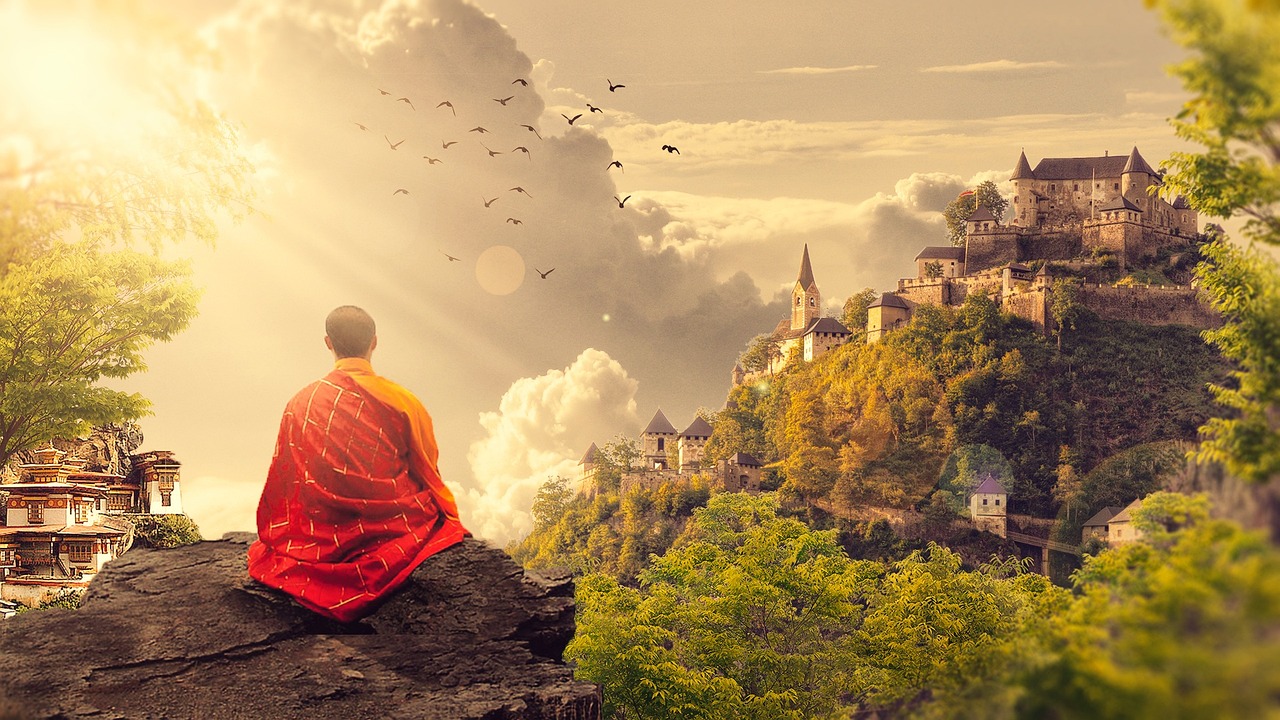 | | Nato Pereira |
These realizations have led me into a new growth path in my own life. I have recently had some changes in my own life that resulted in me living alone for the first time, and then the Covid pandemic has greatly reduced the contacts I have with other people. This gradually led me to the place within myself where I recognized that my primary relationship in life was now with God within me. I have worked to develop a deeper relationship with God by developing daily spiritual practices that are beginning to have profound effects. I now recognize that my relationship with God is very much a complemental one, and that I am the one who must choose to initiate and enhance our communication. I could stay isolated and lonely, or I have a real opportunity to make God my eternal divine lover, who knows me intimately and shares with me all that he can be reveal. There is nothing that I cannot share with my Beloved. My contribution in this mutual loving is to come to know my lover, to try to know what God wants me to do, make the decision that my will be that of my Divine Parent, and to work with all the spirits of God, accepting their help in serving the Divine Family.
The last thing I want to touch on here is inspired by this relevant paragraph that is easy to pass by in Paper 117, God the Supreme:
Upon the completion of the sixth stage of existence and the entrance upon the seventh and final stage of spirit status, there will probably ensue the advancing ages of enriching experience, ripening wisdom, and divinity realization. In the nature of the finaliter this will probably equal the completed attainment of the mind struggle for spirit self-realization, the completion of the co-ordination of the ascendant man-nature with the divine Adjuster-nature within the limits of finite possibilities. Such a magnificent universe self thus becomes the eternal finaliter son of the Paradise Father as well as the eternal universe child of the Mother Supreme, a universe self qualified to represent both the Father and Mother of universes and personalities in any activity or undertaking pertaining to the finite administration of created, creating, or evolving things and beings. [Paper 117:6.7, page 1288.6]
I have no doubt that as we progress through our universe careers, we will begin to incorporate all the personality attributes of God that we can possibly discover in our future experience. Our complete growth as personality must encompass all aspects of our personalities. Jesus’ life on Urantia revealed a full and balanced blending of all the best characteristics of each gender. Given that we will represent God as Father and Mother, we must embrace everything possible that could be considered masculine or feminine as we would now regard these attributes of gender on this world. Attributes that our society now considers masculine and feminine, and like others that we cannot even imagine now, will be seamlessly blended throughout our being.
So let us all embrace all that we can of the feminine and masculine attributes that we are capable of now. To accept and express what may be thought of as feminine or masculine qualities does not make us less of a woman or a man. But it does make us more complete human beings, growing souls in a universe filled with diversity and endless possibilities.
|
|
André Desjardins, Canada 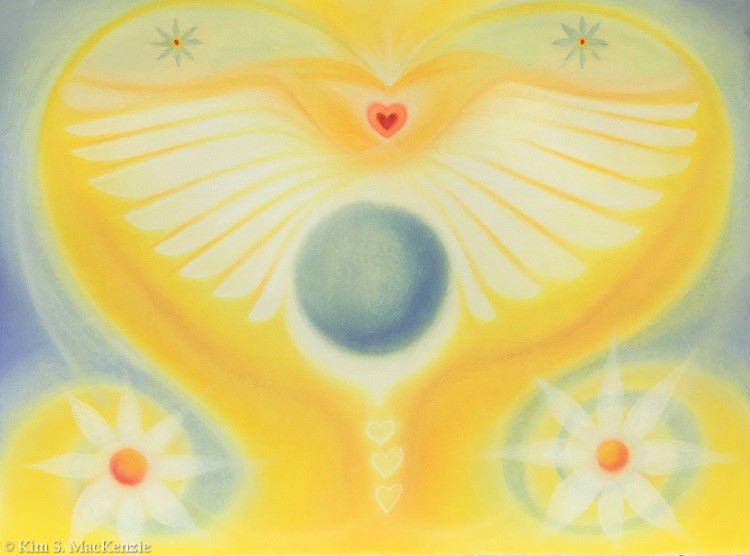 An archangel of Nebadon mentions:
An archangel of Nebadon mentions:
You should understand that the morontia life of an ascending mortal is really initiated on the inhabited worlds at the conception of the soul, at that moment when the creature mind of moral status is indwelt by the spirit Adjuster. [Paper 48:6.2, page 551.7]
This quotation indicates that morontial life begins on our planet at the formation of the soul through a sincere moral choice, heralding the arrival of the indwelling Thought Adjuster. The joint formation of the morontial soul with the Adjuster provides access to morontia realities, and it is possible for a human personality to know and experience a taste of morontia life during his or her earthly life with the absolute conviction of being part of this great morontial family.
The Urantia Book gives us some information about the activities in the schools of education and training on the morontia worlds in Papers 47 and 48. These papers give us an opportunity to study and join these morontia schools during our earthly life. Man has the power to transcend time and space and live as if in direct contact with the Heavenly Father through his vast personality circuit and through the indwelling presence of the Thought Adjuster. "Man’s ability to transcend himself is the one thing which distinguishes him from the animal kingdom" [111:6.9].
The morontia nature of the soul necessarily involves the first steps in morontia life, and its evolution allows human personalities to access morontia realities guided by their indwelling Adjuster and assisted by other mindal and spiritual influences. All these influences are essential to guide personalities in the evolution of their morontia soul through the psychic circles. The seventh psychic circle heralds the beginning of morontial evolution for personalities and:
This signifies the united function of the seven adjutant mind-spirits under the direction of the spirit of wisdom, the encircuitment of the mortal creature in the influence of the Holy Spirit, and, on Urantia, the first functioning of the Spirit of Truth, together with the reception of a Thought Adjuster in the mortal mind. Entrance upon the seventh circle constitutes a mortal creature a truly potential citizen of the local universe. [Paper 110:6.13, page 1210.8]
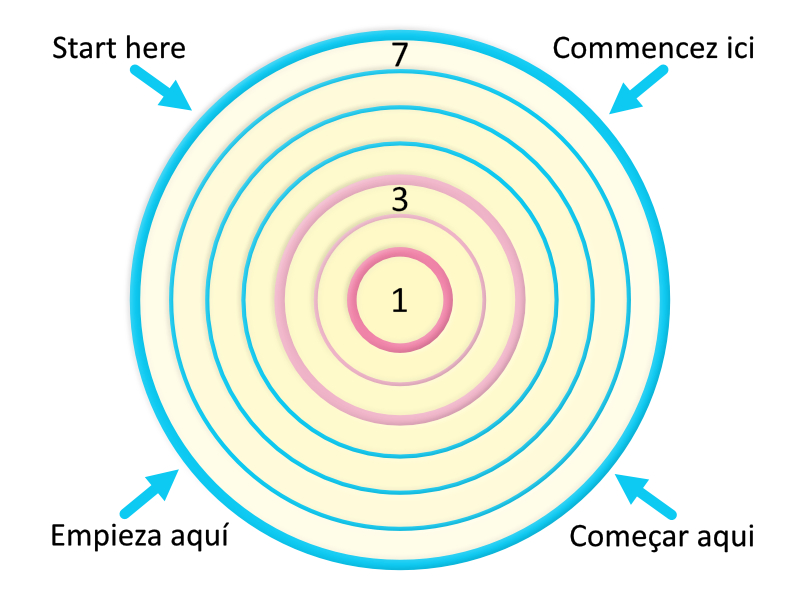 The seventh circle is the starting point for the evolution of the morontia soul and is the first circle to be attained by the personality since it involves the unification of the seven adjutant mind spirits, the influence of the Holy Spirit, the operation of the Spirit of Truth, and the reception of the Thought Adjuster.
The seventh circle is the starting point for the evolution of the morontia soul and is the first circle to be attained by the personality since it involves the unification of the seven adjutant mind spirits, the influence of the Holy Spirit, the operation of the Spirit of Truth, and the reception of the Thought Adjuster.
The psychic circles represent levels of personal mental attainment, a concrete realization of the seven adjutant spirits and the reception of a Thought Adjuster. The attainment of the seventh circle transforms the individual into a true “potential citizen of the local universe.” Like the Spirit-Adjutants, the psychic circles include seven stages of individual and progressive growth.
It is difficult precisely to define the seven levels of human progression, for the reason that these levels are personal; they are variable for each individual and are apparently determined by the growth capacity of each human being. [Paper 110:6.7, page 1210.2]
This quotation reveals the difficulty of specifying the progressive levels in penetrating the seven circles; it concerns exclusively the volitional attributes and the sovereign status of the personality. The Solitary Messenger also mentions:
The seventh circle. This level is entered when human beings develop the powers of personal choice, individual decision, moral responsibility, and the capacity for the attainment of spiritual individuality. [Paper 110:6.13, page 1210.8]
Four powers stand out in this seventh circle: It is actually the first for the personality and is the beginning of personal progression through the higher circles; it initiates the phenomenon of personal evolution within the psychic circles accompanied by a Thought Adjuster. "Entrance upon the seventh circle marks the beginning of true human personality function" [110:6.1].
The seventh circle is not very well defined in relation to the others but concerns exclusively the status of the human personality; it forms a set of four elements (or powers) as stated before and is considered to be the first group of four circles that demonstrate the advancement and evolution of the personality within the psychic circles. These are:
7th - Personal choice
6th - Individual decision
5th - Moral responsibility
4th - Ability to attain spiritual individuality
Considering that the ascending career begins with a personal choice favorable to the arrival of the indwelling Adjuster, it would be fair to say that the seventh circle involves a personal choice associated with absolute sovereignty and free will of the personality.
By associating these four elements, starting from the seventh circle by making a personal choice; the sixth circle logically implies an individual decision by that personal choice. An individual decision engages the personality in the fifth circle towards moral responsibility for that individual decision and, finally, moral responsibility weaves the link to the fourth circle; spiritual individuality through the sovereign free will of the personality.
This seventh circle (the first reached) is composed of four separate elements that can be coordinated simultaneously by a sincere moral choice, an individual decision, a commitment to one's moral responsibility, and one's ability to achieve spiritual individuality. It is through the status of the personality and the primacy of will that these four circles function in harmony. I believe this is the reason why the seventh circle is hardly defined by the Solitary Messenger, because it concerns only the evolution of the individual status of the human personality.
After attaining the status of spiritual individuality through the first four circles (7 to 4), the personality emerges in the third circle of morontial evolution and is then assigned a personal seraphic guardian:
The Adjuster’s work is much more effective after the human ascender attains the third circle and receives a personal seraphic guardian of destiny. While there is no apparent concert of effort between the Adjuster and the seraphic guardian, nonetheless there is to be observed an unmistakable improvement in all phases of cosmic achievement and spiritual development subsequent to the assignment of the personal seraphic attendant. When the third circle is attained, the Adjuster endeavors to morontiaize the mind of man during the remainder of the mortal life span, to make the remaining circles, and achieve the final stage of the divine-human association before natural death dissolves the unique partnership. [Paper 110:6.14, page 1210.9]
The third psychic circle represents a culmination in personal development after the attainment of spiritual individuality by the association of the four elements, or powers, of the seventh circle. Movement to the third circle denotes an improvement in cosmic accomplishments and in spiritual development.
From the seventh to the third circle there occurs increased and unified action of the seven adjutant mind-spirits in the task of weaning the mortal mind from its dependence on the realities of the material life mechanisms preparatory to increased introduction to morontia levels of experience. From the third circle onward the adjutant influence progressively diminishes. [Paper 110:6.20, page 1211.5]
As soon as the personality has reached the third circle accompanied by his seraphic guardian, he approaches the second circle; the circle where:
…the Adjuster endeavors to morontiaize the mind of man during the remainder of the mortal life span, to make the remaining circles, and achieve the final stage of the divine-human association before natural death dissolves the unique partnership. [Paper 110:6.14, page 1210.9]
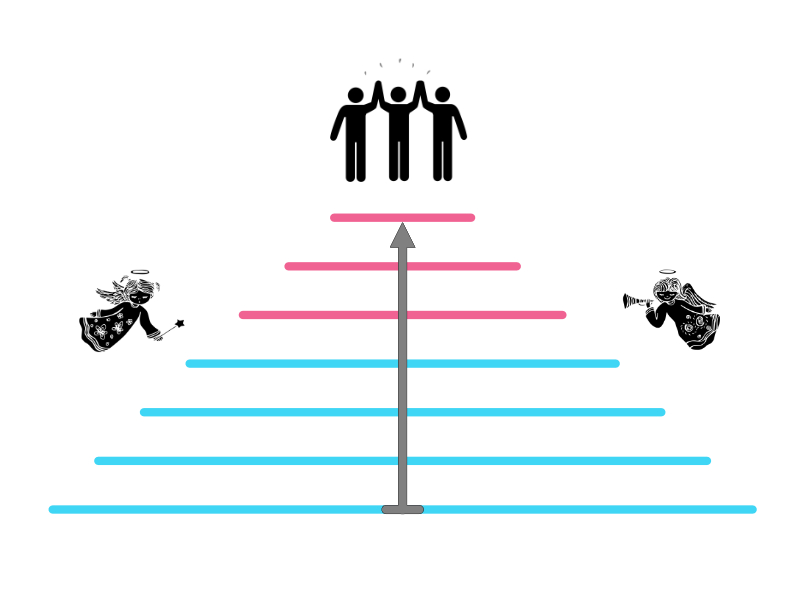 The morontia life of a moral personality begins on his home planet at the conception of his soul in partnership with his Thought Adjuster; it is through the second circle that the Adjuster endeavors to make the mind of the personality morontial during his mortal life by means of mental transformations, by a manner of being, acting, or reacting according to the events of daily life which promote the progression of the soul.
The morontia life of a moral personality begins on his home planet at the conception of his soul in partnership with his Thought Adjuster; it is through the second circle that the Adjuster endeavors to make the mind of the personality morontial during his mortal life by means of mental transformations, by a manner of being, acting, or reacting according to the events of daily life which promote the progression of the soul.
The attainment of the first circle "is the nearest possible approach of material mind and spirit Adjuster in human experience" [110:6.15]. This first circle is the final circle of progressive fulfillment of a human mortal before fusion. Eternal fusion always depends on the absolute will, the free will of the personality and its dedication to do the will of the Paradise Father.
In summary, I propose that the seven psychic circles are as follows in the order of the evolution of the human personality:
7th - Personal choice.
6th - Individual decision.
5th - Moral responsibility.
4th - Ability to achieve spiritual individuality.
3rd - Phases of cosmic fulfillment and spiritual development.
2nd - The Adjuster strives to make man's mind morontial for the rest of his mortal life.
1st - The closest possible relationship between the mortal mind and the spiritual Adjuster in man's experience.
Traversing the psychic circles is part of the personal experience of the human personality in its morontial growth during its temporal life and is the fulcrum that provides access to the mansion worlds. As presented by a Solitary Messenger of Orvonton: "Therefore does a seventh circler go on to the mansion worlds to attain further quantitative realization of cosmic growth just as does a second or even a first circler..."[110:6.18].
Psychic circles are related to mental transformations and the individual progression of personalities in aspects of consciousness; these are in action as soon as the personality uses its mental abilities in a quest to live divinely, according to the will of the Heavenly Father. Morontia life begins with the formation of the soul on our planet; its growth and evolution always depend on the decisions, free will and absolute will of the personality.
Proposed Segments of Psychic Circles
Although the psychic circles are always concerned with the mental aspects of personality, they are divided into four different segments: "The psychic circles are not exclusively intellectual, neither are they wholly morontial; they have to do with personality status, mind attainment, soul growth, and Adjuster attunement" [110:6.3].
1 - Personality status
2 - Mental achievements
3 - Soul growth
4 - Agreement with the Adjuster
Personality status is linked to the first four circles (7 to 4) and corresponds to the first segment of the circles.
Mental achievements are connected to the third circle and correspond to the second segment of the circles assigned to all phases of cosmic achievement and spiritual development.
Soul growth is related to the second circle and corresponds to the third segment of the circles where the Adjuster strives to make man's mind morontial for the rest of his mortal life.
Agreement with the Adjuster is related to the first circle and corresponds to the fourth segment of the circles, which is the closest possible match between the material mind and the spiritual Adjuster in the experience of man.
These four segments of the psychic circles always concern the mental progression of the personality through four progressive stages of evolution and is a personal experience and acquisition as a result of one's own individual efforts. Through these four levels of psychic circles, and considering that morontial life begins as soon as the morontial soul is created through union with the Thought Adjuster, it is possible to reach a morontial state before bodily death and to come to live in accord with one's indwelling Adjuster.
The human mind is in no way bound to time and space by transcendence but is entirely bound to the prerogatives and free will of the personality. The psychic circles are therefore the seven personal stages of morontia progression during the earthly life.
The individual progress of human beings is measured by their successive attainment and traversal (mastery) of the seven cosmic circles… [Paper 49:6.8, page 569.3]
|
|
Peter Walker, USA 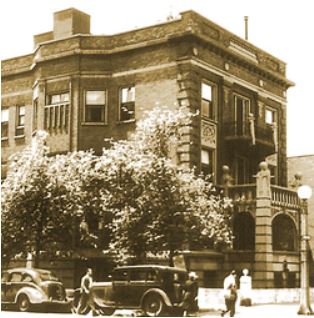 In the Spring of 2018, I read of the new library in the Urantia Foundation’s building, dedicated to containing the works of literature assumed to have been used by the revelators in the Urantia Papers’ formation. Over the years, I have wondered about the origins of the Urantia Papers and reviewed such websites as Matthew Block’s Square Circles in his efforts to match The Urantia Book to human sources. The new library at the Urantia Foundation preserving such works is an invaluable collection, especially for future generations.
In the Spring of 2018, I read of the new library in the Urantia Foundation’s building, dedicated to containing the works of literature assumed to have been used by the revelators in the Urantia Papers’ formation. Over the years, I have wondered about the origins of the Urantia Papers and reviewed such websites as Matthew Block’s Square Circles in his efforts to match The Urantia Book to human sources. The new library at the Urantia Foundation preserving such works is an invaluable collection, especially for future generations.
Having studied The Urantia Book for years, I am still amazed at the quality of the English language used in the papers. The Urantia Book is a masterpiece of prose literature with its poetic cadence, with each author representing their thoughts through the written word. The style of the Urantia Papers is exclusive from any human author’s works I have read. Even the style of each author is unique. Each has its unique writing style, from a Divine Counselor to a Solitary Messenger, Mighty Messenger, or the Midwayer Commission.
One of my favorite passages, one of the most beautiful works of prose poetry I have ever read, is the opening section of Paper 102, The Foundations of Religious Faith. This excerpt, traced to Bertrand Russell’s A Free Man’s Worship, turns Russell’s pessimistic sentiment into a statement of resonating truth and beauty. I still remember reading this for the first time. How ironic such a profound passage in The Urantia Book was sourced from the most well-known atheist of the 20th century!
Nearly 30 years ago, in the summer of 1989, I introduced The Urantia Book to a friend with a vintage English dictionary. He took an interest in The Urantia Book, and with his dictionary, we decided to explore the meaning of Urantia. Since such a term is not defined, we searched through many similar expressions and determined Urantia as meaning “of or belonging to the Heavens.” Since then, I have remembered that definition. As I read The Urantia Book these days, I listen to the audio version, and while doing so, I refer to an online dictionary to clarify the meanings of certain words.
Realizing the importance of a dictionary from the same period as the Urantia Papers, and with the new library at the Foundation, I thought to donate a vintage dictionary. Reviewing various dictionaries, Webster’s New International Dictionary Second Edition was the ideal choice, first published in 1934, the same year the Urantia Papers were finalized. In looking at suitable stands for the dictionary, I could not find an ideal match on several retailer sites, and online auctions rarely sell these items. As such, I had one made by a craftsman in Oregon.
Before shipping the dictionary and stand to Chicago, I researched the word “Urantia” again to review its meaning. Glancing through the Internet, I discovered similar definitions for “Urantia” but felt I might refine it further. The word “Urantia” is broken into two separate parts of “Uran” and “tia.” I found it interesting that there are two similar words whose specific definitions are no longer used in the English language today, even removed from the current Webster’s dictionary. These words are “Urania” and “Uranian,” which are related to the root “Uran.” These definitions are found only in earlier 20th-century English dictionaries. The descriptions are as follows:
Urania - (Latin fr. Greek) “heavenly, heaven.” (Greek) Ourania, Ouranios - "heavenly" Ouranos - "heaven"
Uranian - “Of, pertaining to, or concerned with the heavens, or the science of astronomy; astronomical.”
Reviewing the definition for “tia,” which has Latin and Greek origins, is related to the suffix “cy,” which has the following meaning:
-cy (-tia [Latin, Greek]) “signifying state, quality, office, rank.”
I am not an etymologist, but looking at the context of the word Urantia it would have its origin as an adjective forming the actual use as a proper noun. As such, I postulate the meanings as follows.
u·ran’tia \yu̇·rān’ shə\, adj. 1a: [L., fr. Gr.] of or belonging to the Heavens;
b: having a heavenly status or quality
U·ran’tia \yu̇·rān’ shə\, n. (cosmology). 1a: a name designating the planet Earth;
b: the Earth within the Heavens
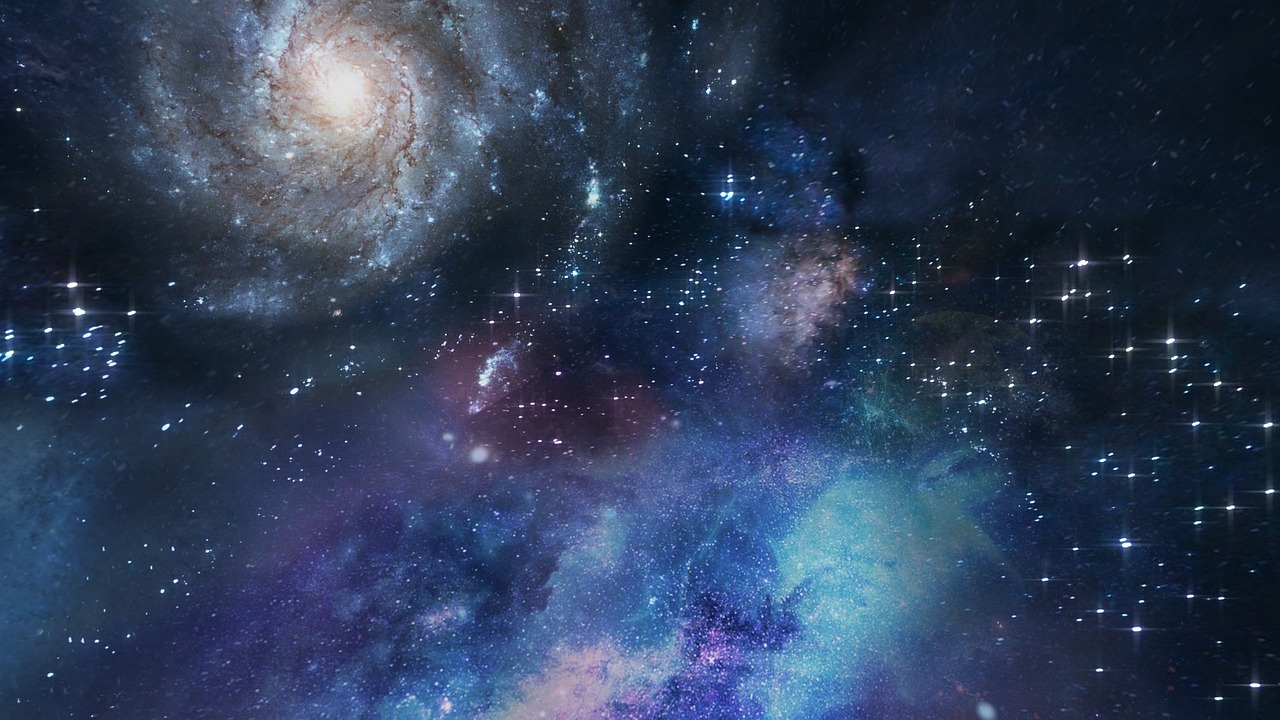 | | Alex Meyers |
In its last definition, “the Earth within the Heavens” has the words “Earth” and “Heavens” in the proper case, designating their specific reference and location. Choosing the name “within” took some liberty of thought but anticipating what the revelators envisioned in formulating a meaning, Earth’s future would inevitably evolve into a status of Light and Life. As such, Urantia would embody a state of “heaven on earth” and be a member of the Heavens in the eternal future of the Grand and Master Universe.
Access to a vintage dictionary is invaluable for referencing language changes. Even now, 85 years after the completion of the Urantia Papers, the English language is altering the meanings of certain words. For example, the term “universe,” which still includes the definition of “a galaxy or group of galaxies” as relevant to the Urantia Papers, is now different from the standard description used today, which represents the millions of galaxies in their entirety, thanks in part to the advancements in astronomy.
Reviewing how languages change over time, I can think of three causes that alter their course. I am sure there are other influences as well.
Infusion – the colonization of countries that blend languages, as when France occupied England and incorporated French words into the English language
Isolation – the separation of societies that create unique words, definitions, and even different languages altogether, such as the Korean language
Transformation – the modernization of languages influenced by changes in culture, science, and standardizations, enhanced by such factors as social media
A unification of languages will inevitably occur with the future of language and our planet’s progress. Paper 55, section 3, regarding the Golden Age of Light and Life, states:
During this age of light and life, the world increasingly prospers under the Planetary Sovereign’s fatherly rule. By this time, the worlds are progressing under the momentum of one language, one religion, and, on normal spheres, one race.
Although the Sun now sets on the British Empire, its legacy of spreading the English language remains. The English language will most likely become the one language of Urantia while continuing to be influenced by other languages and cultures. In time, a standardization of the English language will render further unification and direction.
In the eras to come, avid students of The Urantia Book will reference the English language used during the creation of the Urantia Papers. Eventually, like the one now in the Foundation’s library, vintage dictionaries will be available online so that definitions of the English language from the 20th century will be accessible to everyone.
In conclusion, it is not just the notes in music but the changes between the notes that constitute the melody. In the revelation of the Urantia Papers, regardless of the language, it is not just the words but the insights they represent that transform their concepts into spiritual meanings and values.
|
|
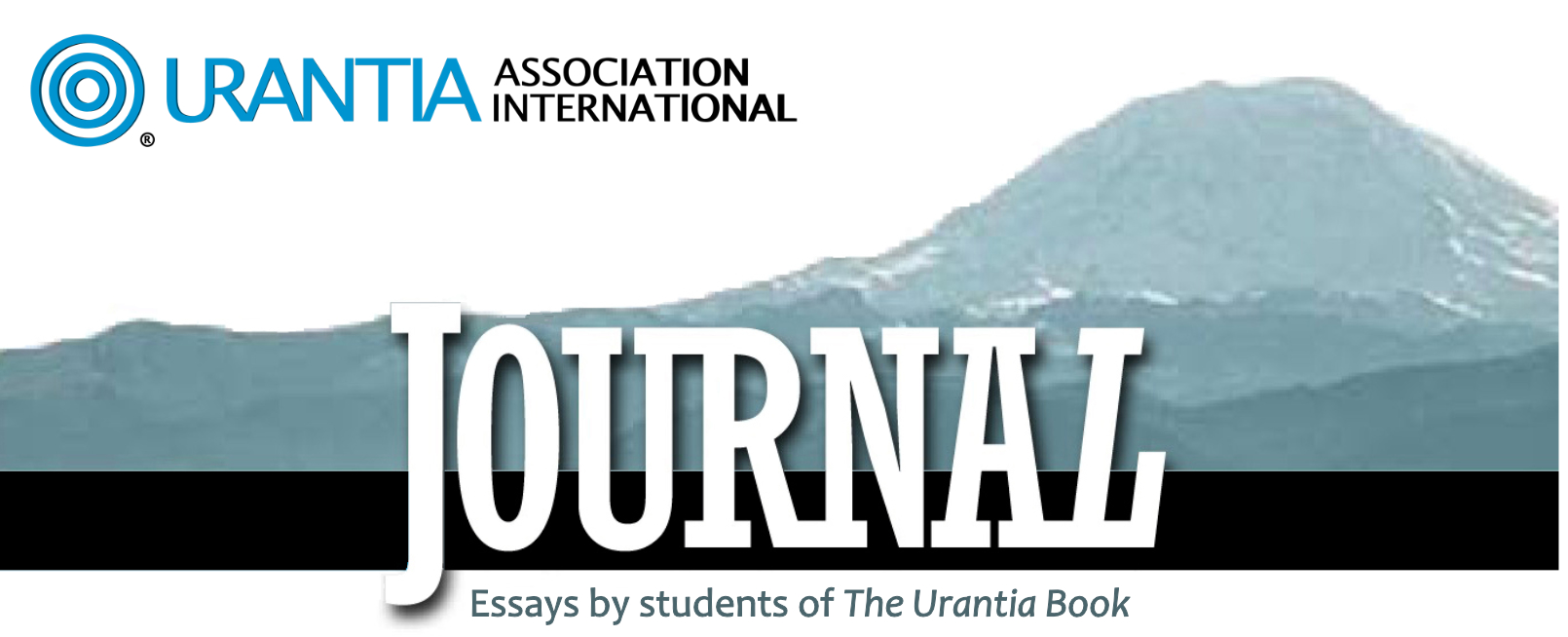
The Journal is produced twice yearly and contains essays, articles and study aids by readers and for readers of The Urantia Book. Any interpretations, opinions, conclusions, or artistic representations, whether stated or implied, are those of the authors and do not necessarily represent the views and opinions of Urantia Association International, the National or Affiliate Urantia Associations, or the editorial team of the Association's Journal.
You can view the entire collection of issues in the archives. All issues before 2017 are downloadable PDF format.
The Journal is currently published in English  , French , French  and Spanish and Spanish  . (There are some older issues that were published in Finnish . (There are some older issues that were published in Finnish  .) You can view the French and Spanish Journals by clicking on the language choices in the pull down menu at the top of the page. .) You can view the French and Spanish Journals by clicking on the language choices in the pull down menu at the top of the page.
Subscriptions
The Journal is available electronically free of charge for anyone with an email address. Join our mailing list to receive free electronic copies.
To receive hard copies, you may subscribe to the Journal at the annual rate of $15.00 USD via any of the following methods:
- To subscribe on line click here
- To subscribe by telephone call: +1-773-572-1180
- To subscribe by check or money order, please send in $U.S. dollars only and make payable to “Urantia Association International”. Mail to:
Urantia Association International
4000 W Montrose Avenue #606
Chicago, IL 60641
Journal Team
- Chief Editor: Richard Jernigan
- Editors: James Woodward, Mark Blackham
- French Newsletter: Alain Cyr and Lucas Perier
- Spanish Newsletter: Olga Lopez
- Communications Chair: Myra Hight
Journal team is currently seeking reports and submissions from all Urantia Book students.
Submission Policy
The Journal editorial team welcomes all article submissions for consideration for current or future issues. Any submissions not used in the current issue are kept on file for potential future use. Urantia Association International does not compensate any author through payment or in any other manner for such voluntary submissions. The Journal editorial team reserves the right to reject or edit materials as it deems necessary for publication and, if edited substantially, will notify the author for their approval.
Send correspondence or article submissions to the above Chicago address or email the Chief Editor, Richard Jernigan.
Images
All contributors — if you submit images, you must either have the rights to those images or they must be in the public domain. In all cases, please include the appropriate credits.
Journal includes images from Pixabay and Unsplash. Many thanks to these companies and their artists for the wonderful service they provide. Image credits are assigned when available.
Citation Guidelines
Please follow our citation guidelines when quoting from The Urantia Book. These guidelines were revised in April 2023, including different citation styles.
Block Quotes
Block quotes are displayed as a separate paragraph, which can be a complete paragraph from the book or any portion thereof. They do not require quotation marks. Block quotes use the citation format shown below, where the first set of numbers refers to paper, section, and paragraph, and the second set refers to the page and paragraph of the editions of The Urantia Book as published by Urantia Foundation. Please note the punctuation.
The Universal Father is the God of all creation, the First Source and Center of all things and beings. First think of God as a creator, then as a controller, and lastly as an infinite upholder. 1:0.1 (21.1)
If you wish to emphasize words that are not already emphasized in The Urantia Book, add “emphasis added” at the end of the page reference.
First think of God as a creator, then as a controller, and lastly as an infinite upholder. 1:0.1 (21.1) emphasis added
Run-in or In-line Quotes
Run-in quotes form an integral part of your own paragraph. Put these quotes within quotation marks (no italics). They require only a short form citation including paper, section, and paragraph. Notice that the citation is included as a part of the quote with the period (full stop) following the quote. For example:
The Urantia Book starts out with a positive assumption, "The Universal Father is the God of all creation” (1:0.1).
Any run-in quote exceeding four lines should be separated out as a block quote. And similar to block quotes, any emphasis added to a run-in quote requires adding "emphasis added" to the citation.
Paraphrasing
If you paraphrase a quote, or derive information from any paragraph, use the same run-in quotation style.
The Universal Father is portrayed in The Urantia Book as a creator, controller and upholder (1:0.1).
References to other works
If you use quotes from, or make references to, other works, please include a citation in order to avoid plagiarism.
In these cases, mention Author, Title, and Year, either in the text or immediately following a quote. Alternatively, include the citation as a numbered footnote.
Size of Submissions
Please limit the size of your submission to 4,000 words or less. We encourage you to use your own words as much as possible and to avoid overusing quotes from the book. Direct quotations are more effective if they are used sparingly and for emphasis.
We always welcome articles about personal spiritual experiences as well as those with fresh insights and new perspectives. Also of interest are thematic studies and articles that compare, evaluate, or integrate academic research (scientific, social, religious, or otherwise) with the teachings of The Urantia Book.
|
|

